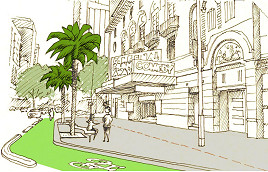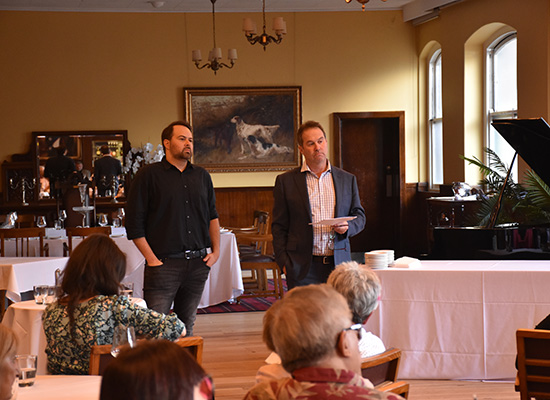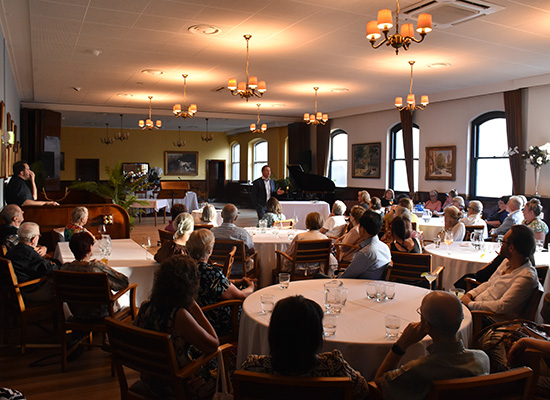“An enormous safety problem”: CBD locals meet with council CEO
In an open address to Residents 3000 last month, the City of Melbourne’s CEO Justin Hanney threw the challenge to locals to “come up with great ideas and initiatives” for the city, as he dealt with a number of contentious issues affecting the CBD.
Speaking at the Residents 3000 meeting at the Kelvin Club on March 3, Mr Hanney – a CBD resident himself – presented on some of the council’s current key initiatives before responding to questions from the floor.
The council’s rollout of bike lanes, the current e-scooter trial, safety, homelessness, graffiti and the state government’s proposed safe injecting room for the CBD were among the key issues of concern to residents at the meeting.
While acknowledging that hybrid work arrangements were “here to stay” for many CBD-based companies and their workers, Mr Hanney said “it was fantastic” to see the city “booming” again following the easing of COVID restrictions.
“People are back out and our pedestrian indicators are showing that. The city has been turned back on and major employers are directing their staff back to work,” he said.
“I’ve had a bit of a wrestle with my own organisation because I’m saying we’re back in the office. Our default position is, we’ve got 1600 staff back in the office and we’re doing that to try and lead by example.”
Bike lanes and scooters under fire
In addition to encouraging workers back to the city, Mr Hanney highlighted a number of initiatives the council had implemented during the COVID lockdowns, including activating laneways and shopfronts, installing parklets for hospitality traders, as well as “putting in 10 years of bike lanes in one year.”
The council’s bicycle lane rollout has come under intense scrutiny as the city emerges from COVID, with many residents raising concerns with the CEO regarding pedestrian safety, low cycling uptake, blocking of emergency vehicle access and increased congestion.
Residents 3000 president Rafael Camillo has continued calls for the council to review bike lanes across the CBD, as residents took aim at bicycles and scooters being ridden on footpaths, as well as reduced space for vehicle access and parking.
“Footpaths are built for people to walk. There are very powerful organisations for bicycles, but no-one is representing pedestrians. Getting on and off a tram is now a very dangerous activity,” one resident said.
“It’s not like Amsterdam where people ride their bikes along the cobblestone,” another said. “Here [Melbourne] people race like they’re in the Olympics.”
“There is an enormous safety problem.”
Another resident also expressed frustration that the council’s consultation with residents over the rollout had been based more on “informing” rather than “engaging”.
But Mr Hanney said the delivery of new bike lanes was based on expert advice and “enormous” community consultation underpinning the council’s 2030 transport strategy.
He also added that many of the new lanes, such as those recently installed along Exhibition St, were part of trials, and that adjustments could be made accordingly.
“The city has a transport strategy, consultation on the strategy was enormous,” Mr Hanney said. “There is transport planning behind it, you might not agree with it, but there’s evidence behind it.”
We know there are currently areas of the city where it is unsafe to ride a bike, so we accelerated the amount of bike lanes while the city was shut down. Why do you think we did that? Because the city was shut down.
“Bike lanes disrupt and with no one in the city we said, ‘right, we’ve got a plan, we’ve got a transport plan’ – we consulted enormously on the transport plan. I saw more consultation on that plan than any other plan I’ve seen adopted by the city. The feedback we received was vast, and it wasn’t just bicycle users.”
“What we’ve done is we’ve put a lot in quickly as trials. At Exhibition St, it’s a trial. There are temporary components to it so we can look at how it actually operates and how can we get input and feedback from people to determine whether it’s working or not.”
In response to concerns raised about bike lanes blocking emergency vehicle access, Mr Hanney said every new lane was installed in consultation with all emergency service providers, while with respect to poor configuration and signalling, he noted that “sometimes, when things go in, there are unintended consequences.”
“They’re the types of things that we’re not always going to get right. What’s the fix? What’s the solution?” he said.
“I promise you, we take a bike lane out I’ll get 200 people saying, ‘it’s not right’, and I’ll get 200 people saying, ‘well done’. It’s always going to be a position of what’s the right decision at that point in time.”
Many residents also expressed safety concerns with the state government’s e-scooter trial, which Mr Hanney said had seen around 60,000 users during its first week.
While scooters illegally riding on footpaths remains an issue of enforcement, Mr Hanney said he expected that the geofencing technology that controlled where scooter riders could travel would only improve as the trial progressed.
“We might not like them, but they’re popular. If you go to any capital city in the world, they have scooters,” he said. “Everyone has got views on scooters. Some people love scooters, some people don’t. It’s a trial.”
“The issue with scooters is that they’re banned from footpaths, and they need to be banned [from footpaths]. Part of the trial we would like to see is better geofencing. The technology is getting better. The trial is going to be really important; your input is really important.”
City safety and homelessness
Local residents and businesses continue to call for more active police surveillance in the CBD amid rising crime and ongoing issues surrounding people sleeping rough.
While acknowledging that the City of Melbourne was only “part of the solution” when it came to housing and homelessness, Mr Hanney pointed to the establishment of the council’s new agency Homes Melbourne as an example of its commitment to the cause.
He said while there wasn’t “a democratic city in the world that doesn’t have homeless people or people with mental health issues in the city”, deinstitutionalisation had seen an “abundance” of people with mental health issues presenting on the streets.
The council has recently launched the Make Room project at 602 Little Bourke St – a building that it owns that will be retrofitted in partnership with Unison, the state government and philanthropic partners to house up to 50 rough sleepers.
Mr Hanney said “providing pathways” was critical to support people out of homelessness, while raising concerns with the lack of decentralisation of welfare services within the CBD, particularly surrounding the Salvation Army’s headquarters at Bourke St.
“For those of you who live in close proximity here, there is a honeypot without question around the Salvos centre. Why? Because it’s the only facility that is really active within the space except for Ozanam,” he said.
“The pathway can only be support. I struggle a little bit, and this is my personal position, with a lot of the crisis services being offered on the street.”
“It is really critical that people who need food support [can access it], and there is a group that goes out with a washing machine in the back of a van that washes clothes.”
“I’ve got no issues with those services being offered. I think, again once you institutionalise these and they’re done on the streets, that you have institutionalised it.”
“The city’s approach to this is going to be to work to identify at least two locations [for housing] across the city [with] one specifically targeted at women.”
“What we’re seeing is a greater representation of women and older women presenting as homeless on the streets. One is that there are pathways, and that more and more people who require that support can be given that support in a dignified way.”
“I’m not dodging this issue. It’s a real issue but it’s a community and it’s a society issue. Our part from the city is ensuring those terrific groups that provide those magnificent welfare support services to the homeless, can do so in locations where people are there and there’s security.”
“And it’s not 300 people in Brendan Nottle’s place just behind us here and an over concentration in those areas. [It’s that those areas are spread.”
Mr Hanney added that when the council had previously requested more “proactive policing” in the form of foot patrols from Victoria Police, statistics had shown a significant reduction in calls to Triple 0.
“If you have two police officers walking down Bourke St, there is a sense of safety,” he said.
He also acknowledged the “level of frustration” with graffiti with more than 21,000 reports to the council during the past 12 months – an increase of more than 7000 on the previous year.
He said the council was currently engaged in a “graffiti blitz”, which was as much about “beautifying the city” as it was about “ensuring that the city presents itself as being safe.”
“We’ve broken up the city into smaller pieces, I’ve given every executive – I don’t care if they’re the CFO or myself – everyone on the executive has been given an area, to oversight, to monitor, to keep an eye. We’ve got a QR code, and we are asking you to keep an eye on it.”
“I support a safe injecting room in the city”
The issue of the state government’s proposed medically supervised safe injecting room in the CBD continues to divide the community, with many residents calling on the government to reinstate more rehabilitation beds.
A recent report from the Coroners Court of Victoria revealed that on average, at least one person died in the City of Melbourne each month during 2020 from heroin-related causes. Experts say the statistics are further proof a safe injecting room is required within the CBD.
The community continues to await the release of a report by former police commissioner Ken Lay that would recommend the best site for the city’s second safe injecting room — believed to be the former Yooralla building on Flinders St.
Seven out of 11 City of Melbourne councillors backed an “evidence-based” approach to the divisive issue on May 25 last year, and referenced the findings of an independent expert panel, which found that the North Richmond site had saved at least 21 lives in its first 18 months and thwarted 271 “extremely serious overdose incidents”.
While the previous council voted against a proposed site near Queen Victoria Market in 2020, the state government has yet to officially confirm the Flinders St site as its preferred location.
In relation to the Flinders St site, Lord Mayor Sally Capp has publicly raised concerns surrounding impacts on local residents and traders, as well as its proximity to nearby hospitals.
The issue was raised with Mr Hanney at the Residents 3000 meeting last month, who asked for a show of hands from the more than 60 attendees in the room as to who supported a safe injecting room in the CBD, and who didn’t. The results were split by around a third to two-thirds, respectively.
“I think I saw about a third of hands go up, so it is about choice, and it probably represents views across the broader society,” Mr Hanney said.
While reiterating the proposal was a matter for the state government, and its best location a matter for councillors, he told the meeting he personally supported it.
“I support a safe injecting room in the city. Why? Because we’ve got people who use heroin in the city and who die. That’s my personal view,” he said.
“I think of one of my younger daughters – if she was using heroin would I want her using in a safe place? Yes. Do I want her using heroin? Absolutely not.”
“But would I want her to get access to all of the support services? Absolutely … I’d want her using in a safe space where she wouldn’t die. It’s a tricky one.”
“Ken Lay knows our views, we’ve worked closely with him. But the city’s position, formally, is that a safe injecting room in the city is appropriate.”
But many expressed their opposition to a second safe injecting room at the meeting, with one community member labelling North Richmond as “a disaster” that would “destroy Melbourne” if established in the CBD.
Mr Camillo said the government “should be investing in more rehabilitation beds before considering another injecting room.”
While the government said it had doubled the number of publicly funded beds available since 2014, a report by Victoria’s Health Complaints Commissioner Karen Cusack last year found Victoria only had 530 publicly funded residential rehabilitation beds, compared with nearly 900 in New South Wales.
“Great cities have people coming up with great ideas and initiatives”
As part of his opening address to the meeting, Mr Hanney said while there were undoubtedly faults with the city, he used the opportunity to implore the community to be solutions focused when providing feedback.
“I do appreciate the city; I love the city and I consciously choose to live in the city. I have and continue to do so. I have no desire to live somewhere else,” he said.
“There are faults with the city, no questions asked. I’m happy to respond to those where necessary and defend them when appropriate.”
“But I would say that great cities have people coming up with great ideas and initiatives. They don’t just come from people writing letters to the editor, they come from groups like this. You’re here because you’re passionate about living in Melbourne.”
In what was perhaps just one of many more “great ideas” to come from locals, owner of Degraves St gift store Clementine’s Melanie Ashe asked whether the council had considered an education program for residents and businesses dealing “face-to-face” with people suffering drug addiction and mental health issues.
“[Education is needed] so that we can respond in a manner that is going to be more positive. I’ve been given a few tips from people I know who have dealt with people with drug abuse, because different drugs require a different response and so on,” Ms Ashe said.
“I’m just wondering if this might be a good opportunity for the City of Melbourne, Residents 3000 and our precinct programs to do a really collaborative education program.”
Mr Hanney said, “I think that’s a great idea.”
“I think it’s something we can do in partnership and I’m happy to put resources into it from the city because it’s a real issue.” •

Council endorses office tower at Flinders Lane despite querying car park demolition







 Download the Latest Edition
Download the Latest Edition